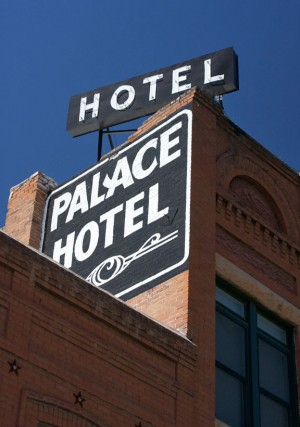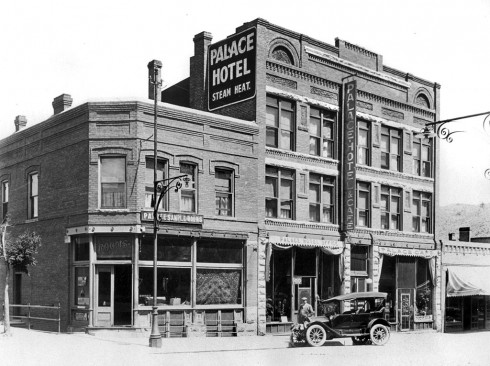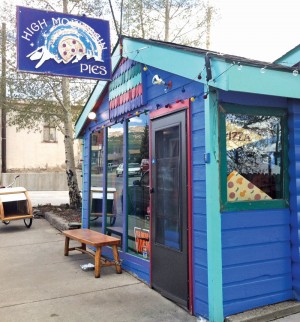New Beginnings in Salida for a 100-year-old Hotel
By Mike Rosso
With the hiss of brakes and a jolt, you’ve arrived. It’s been a long, noisy journey from Kansas City, but now you can get some rest, a cold beverage and a hot meal.
Claiming your luggage from the porter, you step into the slightly chilly evening air and walk over a bridge with the deafening sound of a river at peak runoff below. You head towards the bright lights of town and within a block, you’ve found accommodations. Entering a hotel lobby you line up with other weary travelers at the register, eager to check in. The lobby is full of chatter and men smoking stogies. Several glance up from their seats but quickly go back to reading the Salida Mail.
Ascending the stairwell two flights you walk down the corridor to your room. Behind the sturdy pine door of room 216 is a small but comfortable room with a bed, chair, table and washbasin. The view out the window is due south, facing town. The glow of neon seeps into the room creating an overall reddish cast.
A quick clean up in the lavatory down the hall, a clean suit and you’re back down the stairs and out into the streets of this town with the funny sounding name, “Salida,” in search of a meal and maybe a beer.
TRAINS AREN’T RUNNING THROUGH Salida these days but modern-day visitors can once again relax in a downtown luxury hotel, the first of its kind in many years thanks to the efforts of Fred and Vicki Klein. They purchased the Palace Hotel, a three-story brick building at 204 N. F St., in 2009, spent three years restoring it to even greater glory then during its prime, and recently re-opened it with 15 brand-new luxury suites.
Beginnings: Ambrose Ramsey
Construction began on the Palace Hotel by Ambrose Ramsey in 1906, the same year as the devastating San Francisco earthquake. Possibly due to this, as well as the multiple fires that devastated downtown Salida in the early days, Ramsey was prompted to build the sturdiest structure possible. A solid concrete foundation was poured seven feet below the basement.
The building was designed by architect Charles J. Anderson and included such modern amenities as hot and cold running water and electricity. When it opened in 1909, at a cost of $20,000, it had 44 sleeping rooms.
A coal-fired steam heater is still in evidence in the massive basement but unlikely to be moved anytime soon, said Fred Klein. The thing is the size of a VW and is bolted together. The coal chute is also still in evidence, but many of the original radiators were removed and recycled (several were used in an art installation at the SteamPlant by artist Jimmy Descant).
The Palace was built adjacent to a two-story brick building, the former Windsor Hotel, which was constructed around 1890. Ramsey acquired it as well, providing additional rooms for the Palace. The street-level floor was used as “sample rooms,” a place where train-traveling salesman could display their wares while passing through town (see photo on previous page).
An article in the April 9, 1909 Salida Mail was rhapsodic in its description of the Palace: “Mr. Ramsey’s taste in furnishing these rooms is the marvel of it all. Only the most expensive material has been used in the furnishings, brass-trimmed iron beds, the best coil springs and on each bed a $10 mattress. “The wide steps leading to the second story are carpeted with Brussels, covered with rubber and brass rimmed … the stair opening is enclosed with Texas pine balustrades, bearing a high polish.”
Rail passengers and other guests could expect to pay from 50 cents to a dollar for a room per night. Visitors to the hotel today will find the same front desk that Ambrose had used – a converted teller’s cage from a local bank. During the current restoration, the Kleins discovered not only a bullet hole, but an actual bullet lodged within the desk. Ask to see it if you plan to visit.
Ambrose operated the hotel for only three years and, due to health issues, reportedly leased it out. By 1935 he had retired and turned the business over to his son Delacey, who seemed to be a man of many talents. Records indicate he had worked as an auto mechanic, a clerk at a dry-goods store, as well as a worker at a local creosote plant.
Delacey Ramsey also has a claim to fame as having set the record for a race up and down Tenderfoot Hill in 1914, in his street clothes. Apparently he was at work at a downtown clothing store and spontaneously decided to join the race after being prompted. His record time of 15 minutes and seven seconds held for 60 years.
In 1966 he decided to put the Palace Hotel on the market, and four years later he found a buyer. Jefferson County residents Tom and Pat Bainbridge were looking for a new home to raise their children.
Tom and Pat Bainbridge
A promising deal on 200 acres of land just outside of town initially brought Tom and Pat Bainbridge to Salida from Jefferson County. Arriving to inspect the land, they found it had been sold. A local realtor, Quinn Summers, told them about a downtown hotel which could be gotten for a good price. Pat was not very enthusiastic about the idea, but their four kids all thought it would be grand to live in an old hotel. In the end they won out, and in January 1971, Delacey Ramsey sold the two buildings to the Bainbridges for $25,000.
This didn’t mean Delacey was leaving anytime soon. As part of the contract he was allowed to stay in the hotel for 30 days after the sale was completed. Having lived in the hotel since he was three, he wasn’t in a great hurry to leave. According to Tom, “he just sat there for 30 days,” but after the time allotted, everyone pitched in to help relocate Delacey to his new digs on Fourth Street.
Before leaving, Delacey spoke of some of his highlights at the hotel, one of which was a visit by the “Bloomer Girls,” an all-women’s baseball team that barnstormed around the country pitting the Blonde team against the Brunettes in exhibition games, not unlike today’s Harlem Globetrotters.
Tom and Pat moved their family into an apartment at the back of the lobby and moved their furniture upholstery business into the shop next door (currently the Crystal Shop).
In 1971, rooms at the hotel went for $3.50 a night and the Bainbridges worked both businesses until 1992. During their time as owners they converted several of the single rooms into two-room apartments for longer-term rentals. They also put paneling up over the original plaster that had begun to deteriorate.

Back in the mid-90s there was a big scare at the hotel when a room caught fire. Seems there was a fellow who had stolen a pickup truck in Montrose, came to town, and rented a short-term room. He poured a gallon of gasoline on the floor and set fire to it. With the police and firemen occupied by the blaze, the tenant slipped over to a local bank wielding a .357 with the assumed attention of robbing it. Leonard Post, Chief of Police at the time, had heard about this particular tenant and managed to collar him while ascending the entrance to the bank. Fortunately the room was all that was lost, but it still cost nearly $5,000 to get the room back in shape.
Tom also recalled one railroader who would hand him $40 cash on payday to hold it through the weekend, presumably so he wouldn’t blow it on wine and women. On Monday morning he would get the money back and return to work.
Tom eventually bought the one-story building to the north of the hotel for $7,500 from Vivian Starbuck. He put in a commercial kitchen and leased the space to John and Marilyn Coleman who ran the The Palace Mexican Restaurant for many years (currently 216 Ferraro’s).
By 1990, the Bainbridges had had enough of the hotel business and listed the property. After a year or so on the market, it was sold to Durwood and Joyce Hill. Unfortunately, health issues with Durwood prevented them from being able to run a hotel so, with help from the Bainbridges, sold it to John Mattingly in 1992.
John Mattingly
Colorado Central Magazine columnist law school student and farmer John Mattingly bought the Palace after suffering a brutal San Luis Valley winter in 1992. He wanted to be someplace warmer.
John and his son Mac had a private “hibernaculum” in the basement where they camped out with a pair of old hospital beds, a poker table and a black- and-white TV that got one channel. Occasionally, they would sneak out through the coal chute to buy a sandwich from nearby Mama D’s.
He warned one of his managers, Lisa Star, to “plan for disaster” when managing the Palace. The admonition was based on prior experience with the wiring and plumbing, as well as concerns with the roof, vents, guttering, windows, boiler and brick work.
“Someone in need of random revenge had done most of the wiring in the building, such that switch legs were hot, and line-feeds were not. The attic still had steel wire wrapped in a kind of tar secured to posts, and the number of sub-panels and fuse boxes made it clear that the electrical work had not been done by one person, or company, working from a plan. There were jobbers in Salida who refused to do work in the Palace in the early 1990s, and for good reason,” said Mattingly.
It took him two years to figure out that the cold water was plumbed into the hot water in a concealed chase on the first floor. The result, to the dismay of many tenants, was no cold water in the building. When he finally discovered the feedback loop, the gas bill dropped by about 75 percent.
While John was the owner, the hotel was primarily a residential establishment but an attempt was made to market the “Victorian charm” of the hotel to visitors from Denver. Unfortunately, the insistence of one particular tenant named Sarge to cook side pork while in his underwear, his door opened wide, was found not to be conducive to upscale hotel marketing. (Please visit www.coloradocentralmagazine.com to read John’s entire account of Sarge, the nightmare wiring, and his time as owner of the Palace Hotel.)
During most of his stint as owner, John also employed Todd Sigmier to run the hotel. A suggestion about starting a gallery in the lobby led to the removal of the paneling that hid the plaster walls and the acoustic tile, under which was the beautiful tin ceiling that can be seen today.
After a few years John sold the Palace to Bob and Liz Spencer, who ran it as a long-term rental hotel until selling to Fred and Vicki Klein in 2006.
Fred and Vicki Klein
The Kleins moved from Northern Colorado to Santa Fe, New Mexico, in the late 1970s. Fred worked as a general contractor and specialized in alternative-energy homes, specifically passive solar designs. As the city evolved in the 1980s and ‘90s, so did Fred’s business. He took advantage of the area’s boom at that time and began to specialize in custom homes.
Eventually the bustle of the booming city became too much and they began to look for a transition out of Santa Fe. They discovered Salida on a trip to Northern Colorado and considered a vacation-home type of purchase. They ended up buying a two-story commercial building downtown from Jack and Linda Chivvis and began a remodel of the property. They then heard the Spencers were trying to sell the Palace.
They looked at the building and, as they put it, found the parts to be worth more than the asking price.
“You think you’d be okay here?” Vicki asked Fred when they realized that purchasing this building was making a huge commitment to staying in Salida. They then embraced the idea of a full-blown restoration.
“The bones were good, the feeling was great,” is how Vicki described the building.
The pair, concerned with the safety of the structure, went to the city to learn what was required to bring the building up to code, and the city came back with a list of fire-related code improvements.
One of the first things needed to improve the safety of the building was to remove a tenant who insisted on smoking while on oxygen. Further inspection revealed serious problems with the electrical wiring. (Tom Bainbridge mentioned that he had once hired an electrician who managed to electrify the entire tin ceiling.)
The Kleins decided on a plan to turn the hotel into a series of condominiums – smaller living spaces that people could purchase individually, complete with kitchens and full baths. But then 2008 came along and the bottom dropped out of the real estate market. They decided to go with their fallback idea – running a hotel.
It took some wrestling with the city to get the proper zoning (R1 and R2), as well as conflicting recommendations and requirements of the multiple building inspectors involved; but in May 2012 the Palace Hotel had reopened for business, the only hotel in all of downtown Salida.
The remodeling project took about three years to complete and involved turning 40 rooms into 14 unique suites. They purchased furnishings around the region (what Vicki calls “edgy Victorian”) as well as recycled furniture. In fact, many of the materials that came out of the hotel were recycled, as the Kleins have chosen to take a green-thinking approach to the project. Banks of new photovoltaic panels line the roof of the historic building, providing 9,840 watts of renewable electricity. Thermopane windows have been installed in all rooms to keep heat in – and noise out. Even the walls were given extra insulation. The interior woodwork, which had remarkably been spared the paintbrush in 100-plus years, was cleaned and restored and new doors were ordered to match the decor and original southern yellow pine trimwork.
They serve locally roasted coffee and feature locally made soaps from Blissology.
One thing is probably certain – The “new” Palace Hotel will likely be around well into the 21st century. Ambrose would be pleased.
Notes: Both Ambrose Ramsey and his son Delacey lived to be 100 years old. Special thanks to Jane Carpenter, who did mountains of research on the Ramseys and the Palace Hotel. Much of the info in this article was compiled from her work.




I’ve booked a room for the 2013 FIBARK festival week at the Palace Hotel. My wife and I cannot wait to stay there! Beautiful restoration of a Salida Landmark.